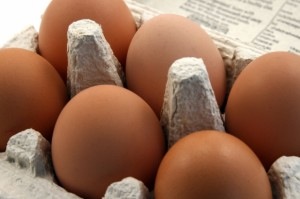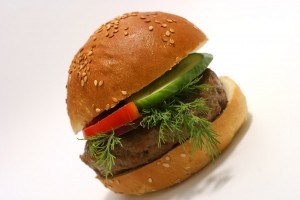It’s time to do some holiday baking. One essential ingredient of most baked goods is: eggs. Needless to say, the fragile little power packages enclosed by brown, white, and sometimes blue shells are key players for breakfast, lunch, or dinner, too.
When you shop for eggs there are a slew of different egg cartons – most of which sport all kinds of claims about nutrients and the personal space of the hens plastered front and center.
The dilemma: how to choose. I would love my eggs to come from happy chickens that run around in lots of space (like my Grandmother’s chicken coop that came with individual wooden nests for each chicken and a large outdoor pen). I don’t know how to tell if hens are happy since they don’t smile, but I guess if they are sheltered, fed, have space to roam and lay lots of eggs they might qualify.
Egg Nutrition
One large egg has 72 calories, 16 in the white, 54 in the yolk. Each has 6.3 grams of protein, 3.6 in the white, 2.7 in the yolk. There are 5 grams of fat, 4.5 of which are in the yolk. 1.6 grams is saturated fat – all of which is in the yolk. There are 212 mg of cholesterol, 210 of which are in the yolk. (There’s the answer to egg white omelettes). There are a whole bunch of vitamins and minerals in these little powerhouses, a lot of which — but not all — reside in the yolk.
The Claims On The Carton
The following information is from a Nutrition Action Healthletter Safe-Food Report.
Verified Or Certified Claims You Can Trust:
- USDA Organic means that the hens have to be uncaged inside barns or warehouses and have to have an unspecified amount of outdoor access. They have to be fed a vegetarian organic diet free of antibiotics and pesticides and can’t have had any antibiotics after they were three days old. Beak cutting (trimmed beaks prevent the chickens from harming each other) is permitted.
- American Humane Certified means that the hens can be confined in cages or they can be cage free. Their beaks can be cut.
- Animal Welfare Approved means that the hens are raised by independent family farmers and in flocks of no more than 500 birds that spend their adult lives outside. They aren’t fed any animal byproducts and their beaks can’t be cut. Their eggs can be found at farmers markets and restaurants.
- Certified Humane means that the hens must be uncaged inside barns or warehouses but can also be kept indoors all the time. Beak cutting is okay.
- United Egg Producers Certified means that the producer must meet minimum voluntary industry standards which, according to the Humane Society, “permits routine cruel and inhumane factory farm practices.”
Claims That Have Not Been Certified By An Organic Or Animal Welfare Organization (aka the companies make the claim – can you trust them???)
- Raised Without Antibiotics should mean that the hens haven’t been fed antibiotics at any time and if the hen was sick and given them, this claim cannot be used for her eggs. FYI: Routine use of antibiotics for hens is illegal.
- Cage Free means that the hens live outside of battery cages in warehouses or barns but they usually don’t have outdoor access. They typically have two to three times more space than their caged brethren.
- Free Range or Free Roaming hens are cage free with some outdoor access although there are not requirements for how much or what kind of access.
- Pasture Raised or Pastured hens romp for at least some time outside foraging for bugs and vegetation.
Then There Are The Nutrient Claims
Because caged and cage free hens usually eat the same diet based on corn there’s no nutritional difference in their eggs. However, some egg producers supplement their hens’ diet with ingredients that they claim produce an increased nutrient value in the egg (like Vitamin E). Always check the Nutrition Facts label for specifics rather than just trusting the claim.
Then there are the Omega 3 claims. The three kinds of Omega 3 fats are DHA, EPA, and ALA. The first two help reduce heart attack risk, lower blood triglyceride levels, and are very important components of your brain cells and retinas. Their most plentiful source is fatty fish like salmon.
The third kind of Omega 3, ALA, doesn’t protect your heart as much as the other two. Most of us get ALA thorough foods made with vegetable oils.
The Hoodwink
Here’s a heads-up: The FDA has banned omega 3 claims on eggs but egg producers still make the claims. Read on.
An egg typically has about 25mg of DHA and 25mg of ALA. If the carton boasts that the eggs have omega 3s but doesn’t specify how much – or – if it says that there are 50mg of omega 3s per egg, chances are it’s just an ordinary egg with the naturally occurring amount of omega 3s and a leading claim.
Some companies supplement their hens’ feed with things like algae or fish meal which can boost the DHA in each yolk to about 100mg. Adding canola oil or flaxseed to the feed can boost ALA to around 350mg.
If the carton claim is that the eggs have 300mg or more of omega 3s most of it is probably ALA and not the more desirable DHA or EPA.







